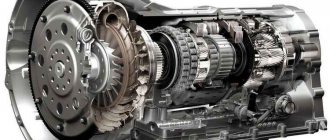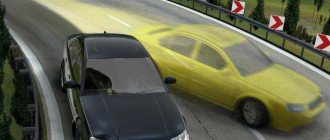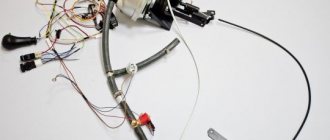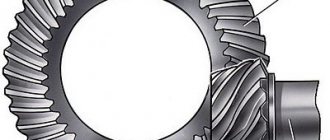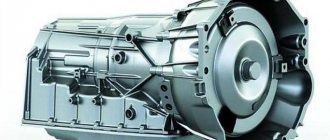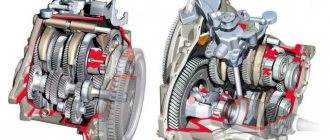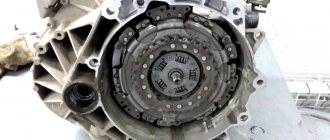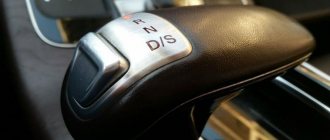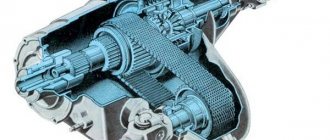If previously tiptronic was a separate method of shifting gears, now it is found in almost any car equipped with an automatic transmission. However, not all cars are equipped with it, so let’s look at what tiptronic is and how it works. We will also look at the pros and cons of tiptronic.
Tiptronic and its main function
Tiptronic selector
The term “Tiptronic” has a dual meaning. On the one hand, this is the name of a brand registered in 1989 and owned by the sports car manufacturer Porshe. On the other hand, it is an automatic transmission, combining the functions of an automatic transmission with manual control.
The Tiptronic system was originally created for motorsport with the aim of providing quick gear changes due to the fact that the control selector has a minimum travel.
It is a misconception that the term “Tiptronic” refers to a separate automatic transmission design that includes a manual gear shift function. Tiptronic is only a function of the automatic transmission, which is designed to control the dynamics of the car in various engine operating modes. This is not available for the classic automatic transmission.
Since the early 2000s, the Tiptronic gearbox has become widespread in the automotive industry.
The first “Tiptronic” in section
Today, this term has become a household name due to the use of automatic transmissions with tiptronic in cars of many manufacturers. Currently, this gearbox can mean any gearbox with the ability to simulate manual control. On the other hand, not every automatic transmission with manual gear shifting copies Porsche design and falls under the terms of the Tiptronic trademark.
Today, automatic transmission with Tiptronic function is used in the following cars:
1. Volkswagen Group:
- Audi;
- VW;
- Skoda;
- Seat;
- Porsche
2. BMW – here this function has a slightly different name – Steptronic.
The same manual shift function is used in the DSG and S-Tronic robotic gearboxes, as well as in the Multitronic CVT.
Tiptronic automatic transmission diagram from ZF
How does tiptronic work?
The history of the appearance of this type of transmission began, naturally, with motorsport, when the use of a sequential type of transmission would be most appropriate. However, racing drivers wanted to combine two devices in one - the convenience of an automatic transmission and a sequential one. Thus, a transmission appeared that involved sequential gear shifting without switching to neutral. At the same time, switching on the gear “every other” becomes impossible.
Initially, the tiptronic was handled by the ZF company, and its implementation by the Porshe company. It was from this period that all automatic transmissions were called tiptronic.
Everyone knows that an automatic transmission uses planetary gears in its operation, and sequential gears simply mean gears installed in a sequential order. This method allows you to obtain enormous torque and maintain the strength of the mechanism. The designers were faced with the task of crossing two methods and getting tiptronic.
Naturally, crossing two mechanisms became an impossible task, so when manufacturing the tiptronic, they took a conventional automatic transmission as a basis, strengthened the planetary gears using special materials and ensured the tightest connection using a conventional transmission torque converter. Thus, the driver moves the shift lever up and receives a higher gear, and when moving down, a lower gear. All actions are carried out using electronics, and to put it into operation, you need to move the selector to a special position.
Design and principle of operation of Tiptronic
The Tiptronic device is practically no different from the device of a classic automatic transmission. And the movement in a car with tiptronic is identical to the movement of a car in which a conventional automatic transmission is installed. The only difference is that the Tiptronic box allows the driver, if necessary, to quickly switch the control selector to manual mode.
The Tiptronic system operates using switches in the gearbox selector and switches (if equipped) on the steering wheel.
The gearbox selector can be equipped with one to three switches: one for switching on the mode, the second and third for switching to lower and higher gears. Signals from the switches are transmitted to the electronic transmission control unit, which runs the program algorithm and ensures gear shifting.
The peculiarity of the gear change algorithm in the Tiptronic gearbox is as follows: when increasing gears, the selector takes the front non-fixed position, when downshifting, the selector moves to the rear non-fixed position. This algorithm differs from conventional gear shifting, where the selector is pushed back to upshift and forward to downshift.
Gear shift diagram
The Tiptronic box operates in two modes: full automatic and manual control. In manual mode, the driver does not simply limit the automatic transmission to using a certain range of gears (for example, no higher than third), but independently decides which specific gear should be engaged.
Automatic mode has the same positions - D, N, R, P, but there is a special cutout on the side for manual mode. When the selector moves into this groove when changing gears, manual control of the gearbox operation is carried out. You can adjust the gear by moving the lever to the “+” or “-” position.
Tiptronic is switched off by moving the gear selector back to position D. On some car models, switching is done using the steering column switches (paddle shifters). The set gear is displayed on the instrument panel.
When you press the steering column switches, the control system switches the box to manual mode, bypassing the selector lever. If the steering wheel paddles are not used by the driver, the control system itself switches the box to automatic mode.
External signs of Tiptronic
On different models and brands of cars, the tiptronic function is activated in different ways. Most often, this is a special sector of movement of the automatic transmission selector handle. When the selector handle is moved to this sector, the automatic transmission begins to respond to specific movements of this handle. Small movements of the handle forward mean an increase in gear, or if towards yourself, then a decrease.
There are models that have two buttons next to the selector knob, “plus” and “minus”, indicating an increase or decrease in the desired gear. But next to it, there is a third button that activates the tiptronic function.
We'll probably repeat ourselves
, but what a tiptronic gearbox is is no longer a secret. Now, copying the tiptronic gearbox of racing cars, you can see the gear shift using buttons on the steering wheel or paddles under the steering wheel. For convenience, the speed indicator is displayed on the dashboard.
If you have a Multitronic variator installed instead of an automatic transmission, then the engine speed and speed of the car will be programmed into your car’s computer, as if you were driving with an ordinary manual transmission.
History of the creation of Tiptronic
First of all, let's clarify the term Tiptronic. This is the name of the technology on automatic transmissions and a trademark of Porsche. After all, they were the first to install gearboxes with manual control over gear selection on their cars.
This development was introduced in order to enhance the similarity of Porsche cars with racing cars on which sequential manual transmissions were installed. The engineers of the German company sought to provide the automatic transmission with a sequential operating mode, adding sportiness without losing comfort.
Why didn’t other manufacturers introduce this function to the machine earlier? Apparently, they did not find an engineering solution that was distinguished by the reliability and durability of the design, because when implementing this function, the mechanical part, and especially the torque converter, experienced an increase in shock loads. But engineers from Stuttgart were able to achieve long-term and trouble-free operation of this unit.
It is also worth remembering Chrysler, which also came close to implementing such a transmission, but it had other priorities during development.
They simply wanted to make the hydromechanical transmission more economical and implemented almost everything that the Germans did, only without the manual gear selection mode.
And technically they had everything ready, all that remained was to add an additional position of the selector lever and implement the work in the automatic transmission computer. Which they later did, but still did not receive the palm.
Benefits of using tiptronic mode
Everyone knows that when using an automatic transmission control system, the dynamic characteristics of the car are reduced. Tiptronic helps avoid such troubles. For example, when performing an overtaking maneuver, the driver can easily switch to manual mode, thereby avoiding the upshift that occurs when using an automatic transmission. Sometimes, on the contrary, it is necessary to lower the gear in order to achieve faster acceleration. This is not possible with an automatic system.
In tiptronic mode, the automatic turns into almost a complete analogue of the manual, but there is no need to depress the clutch pedal. Thanks to this, the car handles perfectly, and the driver has the opportunity to perform complex turns. It is also worth noting that this type of transmission helps to significantly save fuel (up to 15%!). However, this indicator also depends on the driving style and the type of power unit.
Another advantage of tiptronic is the ability to start the car from second gear. This plus is very important in winter, when there is a risk of the car slipping on an icy road. There are no such “bonuses” in a classic automatic transmission.
In off-road conditions, the use of the sport mode also becomes an advantage; it is possible to somewhat smooth out the unevenness of the road surface. At the same time, those sections of the road that are fairly flat can be advantageously used for acceleration. In classic automatic transmissions, “quiet running” is used in such situations. This mode is not so optimal, since uneven road surfaces can only be smoothed out at the expense of reduced speed. That is why, when testing a standard and improved automatic transmission, the second one always passes difficult sections of the road much faster. In addition, tiptronic allows you to tow the car using a cable. It is not recommended to use a standard “automatic machine” for such manipulations.
Separately, it is worth considering braking. If we are talking about a classic automatic transmission, then in case of an emergency you will have to use the foot brake or handbrake. Tiptronic provides engine braking. After stopping the car, you do not need to switch the selector; the gearbox itself will first switch to a lower speed, and then start from 1st gear.
It is not uncommon for novice drivers to mistakenly change gears. Everyone knows that if you switch to parking mode while the car is moving, it is comparable to the effect of a stick inserted into the wheel of a fast-moving motorcycle. Approximately the same effect will occur if you start to back up while moving forward. This is fraught not only with dangerous skidding, but also with complete breakdown of the gearbox. When using the sports mode, such fatal accidents are completely eliminated. If the car owner switches gears to a completely inappropriate transmission mode, the computer simply will not allow this.
When driving in tiptronic mode, gear shifting occurs faster than in classic automatic transmissions, in which the delay can be up to 0.7 seconds. At the same time, the steptronic raises the engine speed to the maximum level for each gear. “Automatic” performs these manipulations more measuredly. However, this does not mean that tiptronic has completely replaced the automatic transmission.
We recommend: What is a tow bar - purpose, types, electrical, production
What is tiptronic
To understand the essence of the technology in question, you need to know what tiptronic is. So, Tiptronic gearbox - what is it?
The tiptronic gearbox is a subtype of automatic transmission, equipped with the ability to switch to manual control mode. The name of the box “Tiptronic”, together with the technology itself, was patented in 1990 by the Porsche concern. For the first time, this type of automatic transmission was introduced into the design of Porsche 911 series sports cars. The boxes were installed in the following versions:
- hydromechanical design;
- 4 stages of switching;
- the box was controlled by a built-in ECU.
The unit was later introduced into Cayenne and Panamera cars. These boxes already had 8 shift stages.
Tiptronic automatic – is it good or bad? Speaking of this, it is important to understand the tasks that the developers set for the unit. German designers wanted to create a car that had a fully automatic transmission on board, but with the ability for the driver to switch to a sport mode, in this approach approaching the sequential gearboxes widely used in motorsport. There were two goals:
- high car dynamics;
- increased driver control over the driving process, similar to that for manual transmissions.
It’s interesting: in parallel with the Germans, the design, the structure and principle of which are similar, was also developed in the American automobile industry: Chrysler created a four-speed Ultradrive gearbox. But in the USA they wanted to achieve different goals: if the tiptronic mode from Porsche emphasized dynamics, then Chrysler prioritized reducing the car’s fuel consumption.
“Ultradrive” in the first versions did not allow manual gear shifting, but it did have adaptive driving modes. “Manual” translation was added in the following models, released on the market under the name AutoStick. But the gear shift option created by Porsche engineers became more successful, and the name “Tiptronic” entered the lexicon as a common noun. These automatic transmissions are now installed on cars of many leading manufacturers, and the BMW concern has its own version of the box design called Steptronic.
Technical features of Tiptronic implementation
In technical terms, it should be noted that Tiptronic is a branch in the operation of a torque converter box when the driver can force the desired gear to be set. This function is implemented using torque converter locking in all gears and some special algorithms for controlling the box electronics.
Locking the torque converter at all stages required enormous talent from the engineers to implement. Since at that time even blocking third gear was considered an unnecessary function and greatly reduced the resource of the unit.
On the gearbox selector, in addition to the standard set of PRND modes, there is a T-shaped branch to the side with one fixed and two non-fixed positions.
One position is indicated by a + sign, and the other, respectively, by a – sign. In fixed mode, we let the box know that we want to control the gear selection itself. And by moving it to one of the non-fixed positions, we indicate which gear to switch to.
We upshift on our own, and downshift on ourselves; it’s impossible to jump over one or more, as you can’t do on a manual transmission. You need to click the selector sequentially to select the desired gear.
This is reminiscent of sequential racing boxes, which is what Porsche engineers intended everything for.
And yet, what is Tiptronic in our automotive life? And this is an assistant. Since it provides us with additional modes characteristic of other torque converter transmissions:
- Winter mode;
- Fuel economy position;
- Sports mode.
Tiptronic gearbox reviews
Before writing this article, we asked some of our users who actually use the tiptronic gearbox and asked for feedback. Below are a few of them: Marina, Cheboksary
I really like driving a car with a tiptronic gearbox.
I have a family: a husband and two children, and one car for everyone. The automatic is very convenient for me and when I drive, they use the normal mode. When my husband wants to ride, it is convenient for him to turn on the titronic and enjoy the ride. In short, everyone is happy and happy! Oleg, Rostov
A long time ago I had a car with a manual transmission, and then friends advised me to take an automatic.
At first I didn’t even think about such a tiptronic mode, and I didn’t even know about its existence. Since I like an energetic driving style, I was simply delighted with the tiptronic. Now with an automatic, I can drive as recklessly as with a manual. Mikhail, Moscow
Previously, I didn’t even think that tiptronic was such a useful thing. In fact, I have been with him for 2 years already and during this time I have realized all the pros and cons. I drive both around the city and outside of it, so I guarantee that in the city an automatic is better, but outside the city, in order to give you agility, it is better to use a tiptronic. Although sometimes when overtaking in the city, I had to switch to tiptronic mode and make the box work more efficiently and faster. Everything is cool, but it is important to remember that you cannot achieve full-fledged mechanics from such a system.
Differences between tiptronic automatic transmission and models with a similar operating mechanism
If you carefully consider the advantages and disadvantages of automatic transmissions with and without tiptronic, you can find out the following:
- The classic automatic transmission is ideal for simple movement on country or city streets, when increased loads on the engine are not needed . If the car is constantly in off-road conditions, then the tiptronic is easier to cope with hills, slopes or obstacles, since the selector automatically selects the best gear to preserve engine power (and with its maximum protection from loads).
- Sudden overtaking and sharp turns are what an automatic transmission with tiptronic implements in ideal form . Other modifications of the automatic transmission are not capable of efficient and safe overtaking in sharp turns.
- The braking efficiency of an automatic transmission with tiptronic is much higher . No other transmission is capable of performing hard braking effectively and safely.
- The ability to start driving from 2nd gear in manual mode makes tiptronic the best solution for driving in icy conditions . Other automatic transmissions do not allow a sharp start on an icy road.
- Simplified off-road driving with tiptronic . The mechanism increases the efficiency of avoiding obstacles without damaging the transmission and engine.
- Protection against incorrect speed selection . If the driver accidentally engages the wrong gear on a classic automatic transmission, the engine will be subject to excessive stress. And this directly affects its durability. If you have a tiptronic box, this will not happen. The electronic control unit responsible for engine operation prevents the selection of incorrect speeds and protects the vehicle.
- Automatic transmission with tiptronic reduces fuel consumption . A classic automatic transmission consumes much more gasoline, since adjusting speeds manually is impossible on it. However, the presence of an automatic system still reduces fuel efficiency, and only a fully manual transmission takes precedence in this area.
Automatic transmission with tiptronic is a modern solution that optimizes a classic automatic transmission and returns more control over the vehicle to the car owner.
Differences between tiptronic automatic transmission and CVT
An automatic transmission is an invention that was created to improve the comfort of a motorist who prefers to drive exclusively in urban environments. Fully automatic control eliminates the need to select speeds - the computer chooses the best option independently. However, some situations still require specific driver actions, and the automatic transmission is not able to entrust them to a person.
Manual gear changing using tiptronic is a solution that optimizes the fully automatic transmission. At the same time, the ability to comfortably drive the vehicle without being distracted by changing gears where it is not needed is preserved.
But there is another version of automatic transmission - a variator. Unlike tiptronic and most other gearboxes, the variator does not have shift stages. Compared to standard gearboxes, it looks much more attractive: there are no jerks when switching, smooth acceleration is achieved, and there are no twitches or dips.
However, a significant disadvantage of the variator is the load transmission link. The vast majority of cars use a belt as a part, and this is a very unreliable element that wears out quickly. Therefore, you need to handle the variator much more carefully than the tiptronic. Cars with a CVT should not be equipped with trailers; they cannot seat more people than the instructions allow, and, moreover, transport trunks full of things.
We recommend: Design and principle of operation of shock absorbers
